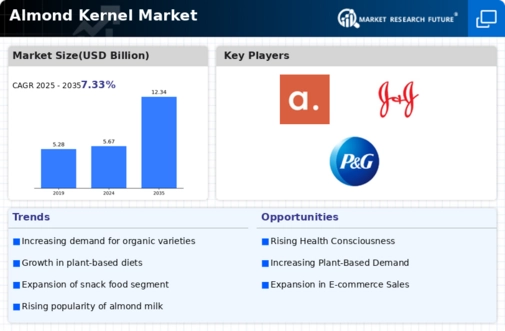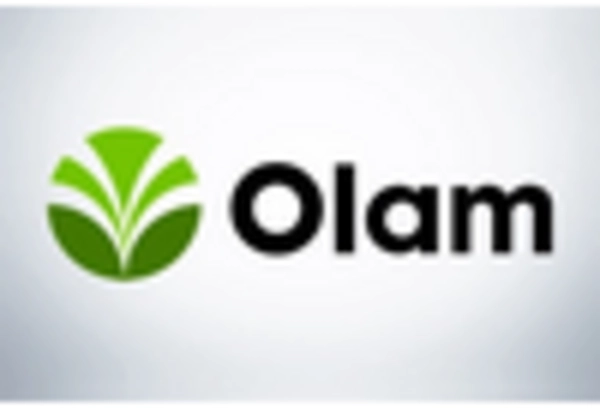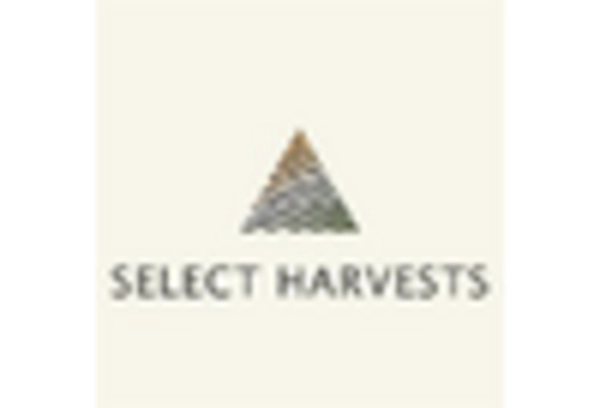Growth in Plant-Based Diets
The shift towards plant-based diets is significantly influencing the Almond Kernel Market. As more consumers adopt vegetarian and vegan lifestyles, the demand for plant-derived protein sources has escalated. Almonds serve as an excellent source of protein, making them a preferred choice among those seeking alternatives to animal products. Market data suggests that the plant-based food sector is experiencing robust growth, with almond products being at the forefront of this trend. This transition not only enhances the market potential for almond kernels but also encourages manufacturers to explore diverse applications, such as almond milk and protein powders, thereby broadening the scope of the Almond Kernel Market.
Rising Demand for Healthy Snacks
The increasing consumer inclination towards healthy snacking options is a pivotal driver for the Almond Kernel Market. As individuals become more health-conscious, they seek nutritious alternatives to traditional snacks. Almonds, being rich in vitamins, minerals, and healthy fats, are perceived as a beneficial choice. Recent data indicates that the demand for almond-based snacks has surged, with a notable increase in sales figures. This trend is likely to continue, as consumers increasingly prioritize health and wellness in their dietary choices. The Almond Kernel Market is thus positioned to capitalize on this growing demand, potentially leading to expanded product lines and innovative offerings that cater to health-oriented consumers.
Expansion of E-commerce Platforms
The proliferation of e-commerce platforms is transforming the Almond Kernel Market by providing consumers with easier access to almond products. Online shopping has gained traction, particularly among younger demographics who prefer the convenience of purchasing food items online. This shift has led to an increase in the availability of various almond products, including raw, roasted, and flavored options. Market analysis indicates that e-commerce sales of almonds are on the rise, reflecting changing consumer purchasing behaviors. As more companies invest in online retail strategies, the Almond Kernel Market is poised for growth, potentially reaching a broader audience and enhancing overall sales.
Increased Awareness of Nutritional Benefits
The heightened awareness regarding the nutritional benefits of almonds is a crucial driver for the Almond Kernel Market. Consumers are increasingly informed about the health advantages associated with almond consumption, including heart health, weight management, and improved metabolic function. This awareness is often fueled by health campaigns and educational initiatives that promote the inclusion of almonds in daily diets. As a result, the market for almond kernels is witnessing a steady rise in demand, with projections indicating continued growth in the coming years. The Almond Kernel Market is thus likely to benefit from this trend, as more individuals incorporate almonds into their dietary regimens.
Innovations in Packaging and Product Formats
Innovations in packaging and product formats are emerging as a significant driver for the Almond Kernel Market. As consumer preferences evolve, manufacturers are exploring new ways to present almond products that enhance convenience and appeal. For instance, single-serving packs and resealable bags are gaining popularity, catering to on-the-go lifestyles. Additionally, sustainable packaging solutions are becoming increasingly important, aligning with consumer values regarding environmental responsibility. Market data suggests that products with innovative packaging are likely to attract more consumers, thereby boosting sales. The Almond Kernel Market is thus adapting to these trends, fostering creativity in product development and marketing strategies.


















Leave a Comment